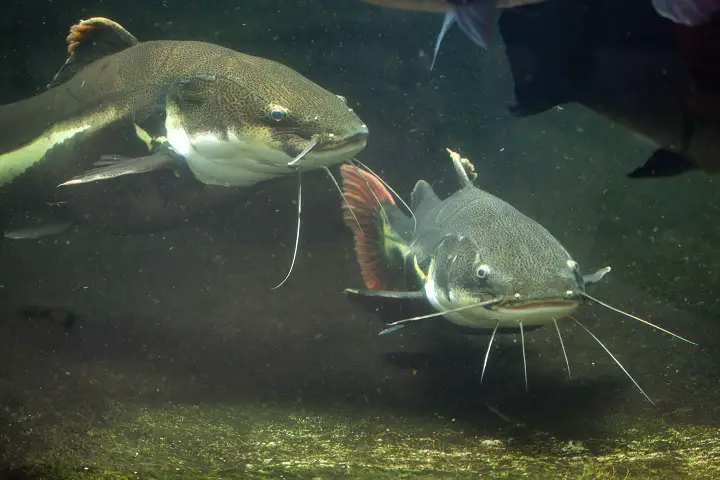
Catfish are extremely exciting fish to catch. Many anglers dream of catching a trophy catfish to really show off their fishing skills.
The catfish family alone has thousands of species, each with unique characteristics. American anglers have for years enjoyed freshwater game fish and the availability of catfish makes the sport all the more enjoyable.
So many anglers, however, are expanding their horizons and casting for fish ignored in the past like catfish. While catfish are worth a fishing trip, so many anglers know very little about these beasts and how to catch them hence the reason for this guide.
What Is Catfish
A catfish is a type of fish that belongs to the bottom-feeding family that thrives in freshwater habitats as well as the coastal areas. Catfish can be found in every continent in the world except Antarctica.
Catfish can be identified by their flattened heads that tend to be broad and long whiskers that protrude from the mouth. The long whiskers contain the taste buds and, as such, are used for smelling and sensing food in the water as well as predators.
However, despite the name catfish, not all species of catfish have whisker-like barbels. There are over 3,000 catfish species in the world, but the number could be higher. While catfish are generally found in fast-flowing streams and rivers, some species have adapted to saltwater environments and some live burrowed underground.
The average length of a catfish is about a meter, but this depends on the species. They can, however, range in size from a centimeter to more than 2 meters long. The largest catfish species is the Mekong catfish that is found in the Mekong river that flows through Thailand, Laos, Cambodia, and Vietnam.
Catfish, in general, are carnivorous, although the small ones eat aquatic plants; generally, they feed on other fish, worms, and insects that are found close to the river bed as well as newts, frogs, small mammals and reptiles that may wander into the water.
Short Catfish History and Biology
Catfish are usually scale-free fish; hence you don’t need an electric knife for precise fillet cleaning. They have long fleshy whisker-like barbels that emerge from their head, as mentioned earlier.
While they swim high in the water column, sometimes, most catfish species are bottom dwellers. Most catfish are not buoyant, which means that they tend to sink to the bottom if they stop swimming.
These kinds of fish have wide, flattened heads with largemouths. Most American catfish don’t have teeth since they suck prey into their mouths. They, however, have cordiform teeth composed of numerous rows of small pointed teeth. The teeth are so tiny that they feel more like rough skin.
Flathead catfish, on the other hand, and a few other species have pharyngeal teeth that are located deeper inside their mouths. Catfish are colored to match their surroundings and avoid being detected by predators.
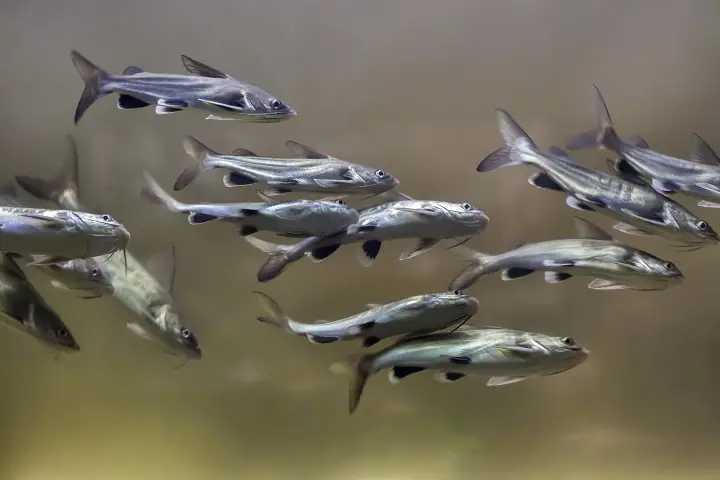
They also have a slimy coat that makes it hard for predators to grip as well as spine like fins that can inflict a nasty cut. Some catfish species produce venom that is injected through the spines. Generally, catfish live in every habitat, although individual spices have distinct preferences.
For instance, some species dwell in large water bodies and rivers, while others prefer small ponds and streams. While catfish are active during the day, their eyes are adapted to seeing in very low light conditions. Their whiskers, which they use to taste and feel, also help them navigate in such conditions.
When it comes to spawning habits, they vary from one species to another, but most of them deposit eggs in a sheltered place like a snag or a deep hole. The baby catfish take after their parents in looks and tend to feed on similar but smaller foods.
Catfish Range Within the USA
There are so many catfish species in the US, but the three major ones that most anglers are familiar with include channel catfish, flathead catfish, and blue catfish, popularly known as the big three.
Some anglers like fishing for bullheads, which are a different species of catfish. There are four species in the bullhead family and they include black, brown, white, and yellow hence the reason why you will hear anglers referring to the white bullhead as white catfish.
Each of the species mentioned is a native to the eastern half of the US. Generally, the bullhead species are natives to the east of the Rocky Mountains together with channel catfish.
Historically the blue catfish was limited to the Mississippi, Rio Grande as well as Missouri river drainages and small portions of the Gulf Coast. Flathead species, on the other hand, inhabited a range that was overlapped and stretched east and west.
Today, people have introduced various catfish species, especially the channel catfish and bullhead species throughout the country thanks to the ability of these fish to adapt to any environment.
Catfish Techniques and Tackle
There are so many ways of catching catfish, but a majority of anglers rely on slow-moving or stationary bait. The main variables that come into play include the bait that you have selected, rigging that you will use, and the location you choose.
Bait
Besides rubberized ice fishing boots, you will need bait if your fishing trip is to be successful. Although artificial lures like soft plastic jigs can be used to catch catfish, most anglers make use of real baits.
Such baits include animals that compose the catfish diet as well as artificial items that resemble what catfish would encounter in the water as food.
Leeches, worms, and crickets are effective in catching small catfish while you can use fish to catch the bigger ones. Since catfish exploit any available food source, shrimp, crayfish as well as shellfish can also be used as bait.
There are so many man-made baits that are available on the market, but pastes, as well as formed baits, are more commonly used. Referred to as stink baits, such products appeal to the powerful sense of smell of catfish.
Additionally, most anglers have realized that catfish can be lured by anything, including products that are found in the kitchen like dough balls, hotdog slices as well as grapes.
Tackle and Rigs
To achieve that stationary presentation that will lure cats to the bait, a majority of anglers will use a sinker or float-oriented rigging. There are so many variations of these, but there are two main methods that are used;
Slip Float Rig
This kind of rig relies on a special float that contains a hollow tube in the middle, through which a line passes through. You can cut a fishing line with a plier so bring one with you.
A stopper, which is usually a small rubber band or plastic, is attached to the line just above the float to prevent it from sliding up the line so that the bait can sink and suspend at a specific depth.
This arrangement makes it easy to reel the bait back to the rod tip, especially when fishing with a bass rod, unlike when you are using a fixed float.
Slip Sinker Rig
Just like the slip float rig, the slip sinker rig relies on the same principle, whereby the sinker can either slide up and down the line and be stopped at a specific point.
However, since sinkers just as the name suggests are heavier than floats, you will need a swivel to act as a stopper and it also helps to slip a bead on the line to prevent the knock from the sliding weight.
In both types of rigs, the catfish can take the bait without much resistance until you set the hook. Speaking of hooks, there are so many that are available for catching catfish. You can either use circle hooks with live bait or three-pronged treble hooks.
Locations
Just like any other bottom-dwelling fish, catfish tend to relate to major structures, especially when they occupy large water bodies. As such, you rarely find catfish in featureless deepwater expanses.
Rather, they tend to hang near river points, channels, ledges, humps as well as holes, although when foraging, they move into shallow coves. Catfish can also be found near weed lines as well as flooded timber patches. During the day, you might also find them in docks.
Catfish Gear
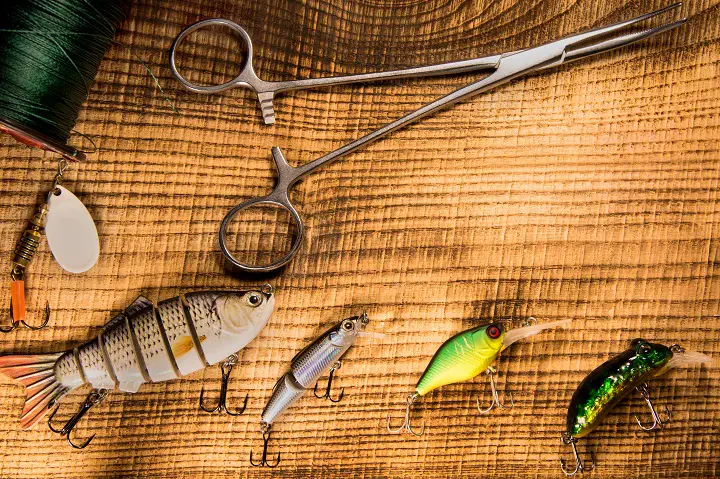
To have a successful fishing trip, you need to equip yourself with the right gear and that includes one of the world’s best catfish rods, a fishing line, and a reel. While there are no hard rules regarding the equipment to use, you are better off sticking with the mentioned ones.
Reels
When it comes to catfishing, you can use any kind of strong fly reel with good flexibility to catch channel catfish and bullheads in which case cane poles, spin casting combos, and spinning reels work perfectly.
If you are a serious catfish angler, however, you are better off with a sturdy baitcasting combo that can handle even bulky bait rigs as well as big fish. You don’t need any fancy features that come with bass-oriented bait casting reels like flipping switches. A line counter, however, is necessary, especially if you are fishing in deep water.
You may want to go with a low profile design, but at the end of the day, traditional reels for spin casting tend to hold more line hence more popular.
Rods
When it comes to fishing rods, you want a rod that is long enough such that you can increase the casting distance whenever you need to.
A 7-foot range rod works perfectly, although there are anglers who prefer rods that are longer than that, especially when hauling big catfish.
Fishing Lines
With fishing lines, you can use a monofilament or fluorocarbon, but it makes more sense using braid depending on its superior strength to diameter ratio which makes it easy for you to store more line on the spool.
Some anglers, however, tend to use monofilament or fluorocarbon leader to alter the bait presentation. Lines that are within the 10 to 14-pound range work for most catfishing scenarios, but if you are catching bigger cats, 50 to 65 pounds work best.
Most Common Types of Catfish
There are several types of catfish found in US waters, each with their characteristics. For success when fishing, you need to be aware of the different species so that you can adjust your approach to suit that particular species.
Channel Catfish
The channel catfish is the most widespread catfish found in most parts of the US. Channel cats range in color from gray to brown and they have several markings and spots on the body.
Description
These catfish can be distinguished from the other species due to their unique features. Channel catfish are similar to blue catfish, although the coloring is different and they also tend to have a deeply forked tail.
Due to their coloring, inexperienced anglers confuse them with flathead catfish. Channel catfish, however, have a protruding upper jaw and a deeply forked tail rather than a slightly notched one. Their coloring is, most of the time, olive-brown to slate and with blue and grey shades on the sides.
Their underside is white or silvery-white. The small ones also have small black spots. Their anal fins have 24 to 29 rays compared to the blue catfish’s ones that are 30.
Life History
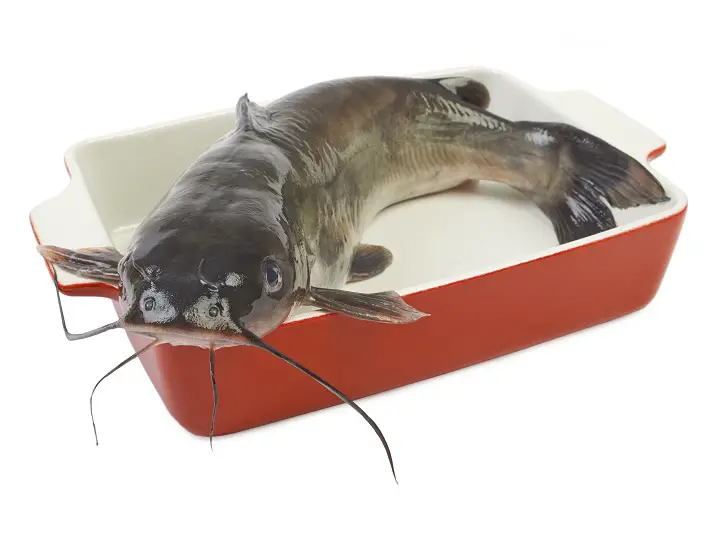
Channel catfish tend to spawn late in the spring or early summer when the water temperatures are at 75 degrees. The males are the ones that select nest sites mostly in dark areas like rock or log cavities.
The eggs are laid at the bottom of the nest and the male catfish guards them until they hatch. The young catfish feed on smaller insects while the adults feed on mussels, fish, crustaceans, insects, and plants. A majority of channel catfish tend to reach sexual maturity in 6 years or when they reach 12 inches in length.
Habitat
Channel catfish are the most adaptable of the catfish species and, as such, tend to thrive in rivers, lakes, small ponds as well as large reservoirs. Typically, they thrive better in water bodies that have moderate currents.
Maximum Size
Of the big three, channel catfish have the smallest maximum size and as such, they rarely exceed 25 pounds in weight. However, a majority of channel fish that you might encounter will probably be between 1 to 5 pounds.
Baits and Techniques
Channel catfish are mostly caught using crayfish, worms, minnows, and shrimp, although hotdog slices, grapes, and artificial stink baits still work. Most channel fish anglers fish at night, although you can still fish any time during the day.
Other
Channels catfish, as mentioned, are the most popular species in the US, coming in second after bass in a lot of areas. One of the reasons why they are so popular is that they not only make for an excellent dish, but they are found in abundance in most lakes, rivers, and reservoirs.
Blue Catfish
Blue catfish are also popularly referred to as hi-fin blue, hump-back blue, high fin blue, Mississippi white catfish as well as blues.
Description
They are close relatives of channel catfish and tend to exceed 100 pounds in weight. Although white or blue, there are several variations, with some being nearly black.
They have a forked tail like the one found in channel catfish, but they can easily be distinguished due to the lack of markings or spots which are present in channel catfish. Unlike channel catfish, blue catfish have 30 to 36 rays on their anal spines.
Life History
Their spawning behavior is similar to that of channel cats, although they are different spices. Most blue catfish will reach sexual maturity when they are about 24 inches in length.
Like channel catfish, blue cats have a diverse diet, but they tend to feed on fish earlier in life. While invertebrates comprise a large portion of their diet, small blue catfish as small as four inches are known to eat fish. Larger blue cats that are more than eight inches long feed on fish as well as large invertebrates.
Habitat
Blue catfish occur in major channels, tributaries as well as major river system impoundments. During summer, they have been known to move upstream in search of cooler temperatures and downstream during winter months.
Maximum Size
Blue catfish tend to reach weights of 20 to 40 pounds, with some reaching more than 100 pounds. Many anglers have regularly hauled blue catfish weighing 50 pounds and occasionally, they will haul a 100-pound beast. The largest blue catfish that was ever documented was 143 pounds, although there have been rumors of blues weighing twice as much.
Baits and Techniques
Compared to channel catfish, blue catfish tend to be more predatory by feeding on other fish. As such, most anglers rely on live or cut fish to catch them, with the oily species being the favorite.
Other
Where mature blue catfish exist, it’s no surprise to find 50 pounders. Like their channel cousins, they make for an excellent dish.
They are the largest species in North America and reside in lakes, rivers, reservoirs as well as major tributaries where there are clear, swift waters. They can easily be found over gravel, sand, and rocky bottoms.
The young take about a week to hatch and the male will stick around to guard them for about a week before they are off on their own.
Flathead Catfish
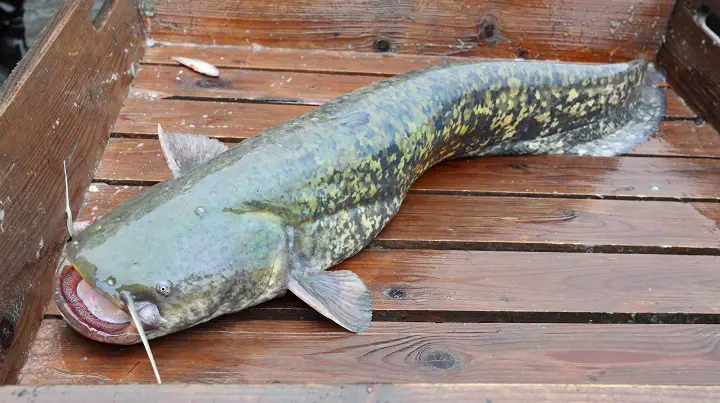
The flathead catfish is a popular species since there are not so many of them in the US and they have been known to grow to very large trophy-class sizes with the largest documented weighing about 123 pounds.
Description
They are brown or yellow, with numerous dark markings or spots on their backs. As the name implies, their heads tend to be flattened, which helps them look for food in soft muddy bottoms.
The lower jaw tends to protrude beyond the upper one, which gives them a distinct appearance when they are viewed from the side. Their tails are not forked like in channel and blue catfish and they have less than 30 rays in their anal fin.
Life History
Unlike blue and channel catfish that are opportunistic predators, flatheads prey only on live fish. The young feed on worms, crayfish, and invertebrates with the diet changing to fish when they are larger.
Their spawning season runs from May to August when the water temperatures are between 75 to 80 degrees. The males will select a nest mostly in hollow logs, trees, and undercut banks.
When a nesting site has been selected, the male will improve it by creating shallow depressions in the mud where the female will lay the eggs.
Flathead catfish are often solitary fish and are known to pick out a spot under a tree or log or an undercut bank and remain there until night falls when they move into shallow water to feed.
Habitat
Flathead catfish prefer water bodies with slow currents as well as higher water turbidity. They can be found lurking in deep water holes, undercut banks, and other sheltered areas where they remain throughout the day until it’s time to feed.
Maximum Size
Flathead catfish will exceed 20 pounds and occasionally top the 100-pound mark.
Baits and Techniques
They are predatory and, as such, will consume fish for most of their lives. As such, they are better caught using live bait since they don’t scavenge for dead prey as their channel and blue counterparts do.
Other
Flathead catfish are the toughest to catch since they are hard to find and will put one hell of a fight when they are hooked. They live throughout the Mississippi, Ohio, and Missouri river basins. They are easy to distinguish from the other species due to their long body and a square flattened head.
Bullheads (White Catfish Included)
Bullheads are common in most Minnesota rivers, streams, and lakes, although they are most common in the southern half of the state.
In terms of habitats, they thrive in slow-moving, quiet waters that have soft sand, gravel, or mud bottoms. The spawning season for bullheads begins in late spring and runs through early summer when the temperatures are about 68 to 70 degrees.
The females use their fins to clear out a saucer-shaped nest in shallow water underneath matted vegetation, overhanging banks, or fallen trees. Both the male and the female guard the eggs until they hatch. When the eggs have hatched, the male takes over and will protect the young ones until they are about an inch long.
Description

All bullhead species tend to have an adipose fin located between the tail and dorsal fins. This small fin doesn’t have any bone or cartilage and feels like an ear lobe.
They also have a rounded tail rather than the forked one found in channel catfish. They have no scales, bodies are covered with taste buds and they tend to be very slippery, which helps them avoid predators.
They also have a single spine that is sharp and is located in the pectoral and dorsal fins. Like other catfish species, they have whisker-like barbels under the chin that they use to locate food.
Life History
The bullheads are well known for their innate ability to survive in waters that other catfish cannot survive in. They can be found in murky waters where oxygen and visibility are at their lowest. They are not known for their large sizes, which makes it easier for anglers to catch them.
Habitat
Bullheads are adaptable and able to thrive in even polluted and anoxic waters compared to other species. They also do well in water bodies that have slow currents, dense aquatic vegetation, and muddy bottoms.
Maximum Size
These catfish are smaller in size by gamefish standards and will rarely exceed a pound or two in weight. The largest is about 4 pounds.
Baits and Techniques
They can be caught using the same techniques as well as baits that you would use on channel catfish, although you are better off downsizing your hooks to accommodate their small bodies.
Other
There are four common species of blue head catfish in the US and they include the brown, black, yellow, and white species, often called the white catfish. Although the different species exhibit minor differences, their similarities often outweigh them.
Other Types of Catfish
As mentioned earlier, the catfish family has thousands of different species, each with unique characteristics.
Ripsaw Catfish
The ripsaw catfish thrives in the Amazon waters and is a danger to fishermen due to its thorny sides that will slice the skin in a second.
However, despite their terrifying reputation and appearance, the ripsaw catfish is never aggressive. They are slower than other fish and the thorny sides are adapted to protect the fish from predators and make up for their slow pace. They grow to almost 30 pounds in weight.
Electric Catfish
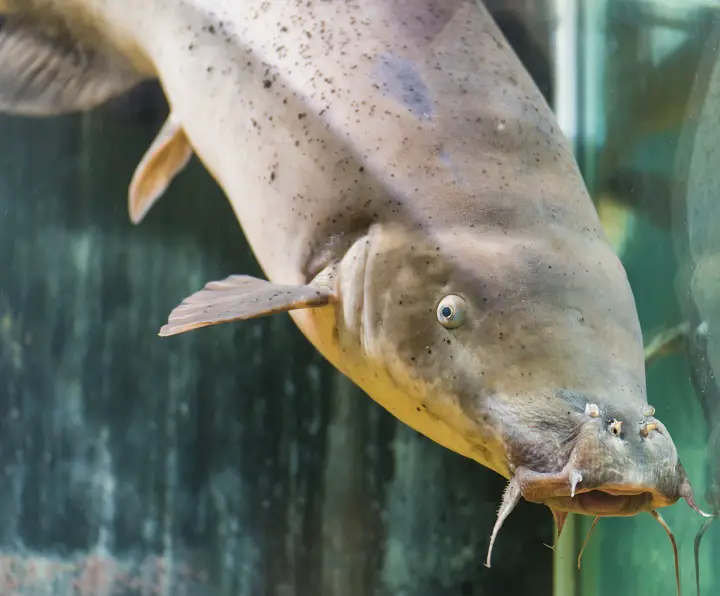
The electric catfish, just as the name implies, produces a shock that can both stun and cause harm to people and predators when it feels threatened just like an electric eel.
Some of the species can create a shock that is over 300 volts thanks to a special organ that makes it easy to produce such an electric shock. They most thrive in African water bodies.
Walking Catfish
The walking catfish can survive easily on dry land for brief periods. When they are out of the water, they rarely flop like other fish.
Rather they will move in a diagonal manner that tends to put weight on the back half of their body, which makes it seem like they are walking. They are rarely eaten since they are considered a nuisance in some parts of North America.
Corydoras Catfish
This species of catfish is popular for aquariums. They don’t grow too large sizes hence adding a certain appeal in aquariums.
Currently, there are over 160 Corydoras catfish species with the most popular being; panda corydoras, bronze corydoras, pygmy corydoras, three-stripe corydoras, spotted corydoras, elegant corydoras, two saddle corydoras, and blue corydoras.
Wels Catfish
The Wels catfish species can be found in eastern Europe seas like the Baltic Sea. They are well known for their enormous sizes since some can grow to over 5 feet long, which makes them a threat to humans. They are considered invasive, which has limited their introduction into the environment.
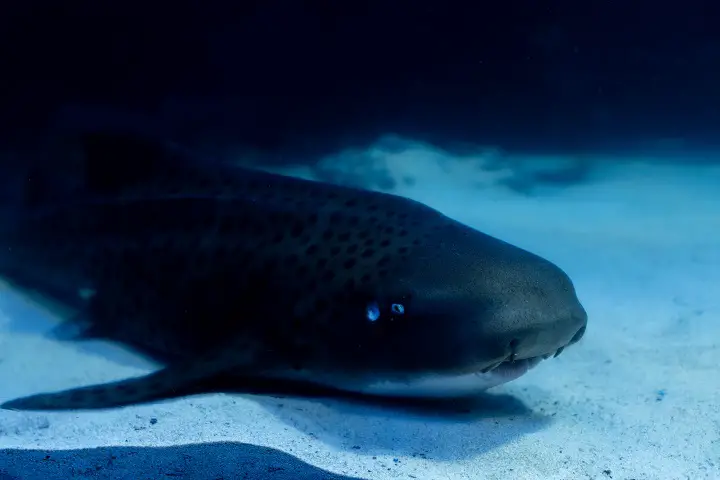
Raphael Catfish
Raphael catfish are popular tropical fish that thrive in South America, which is where they are imported from other parts of the world.
They grow to a size of up to 8 inches long, which is longer than that of corydoras, but they don’t grow large enough to need a huge aquarium.
Amur Catfish
This is a common catfish species found in Japan hence the reason why they are referred to as Japanese catfish, although they are also found in Eastern Asia.
They thrive in rivers that have slow current and will most likely be found in irrigation canals since they provide the perfect environment. They are eaten and often will be brought to inhabit indoor ponds due to their slender appearance, but it’s rare for them to be kept as pets.
Chiapas Catfish
The Chiapas catfish was discovered in 2005. It can grow to a decent size, which makes it surprising that it had not been discovered before then.
Like other catfish species, the Chiapas have barbels; although no one can pinpoint where this species came from, there are unverified theories that point to African roots.
Ghost Catfish
The ghost catfish is also known as the glass catfish due to its transparent appearance. It is native to Asia and can be found in aquariums all over the world due to its unique appearance.
The skeleton of this particular fish can be seen through its transparent skin and its small size is another reason why it’s an aquarium fish.
Mekong Giant Catfish
This is one of the well-known catfish species, mainly due to their enormous sizes. It is not just one of the largest catfish species, but it is also one of the largest fish in the world and has been featured in TV shows such as River Monsters.
The Mekong giant catfish are known to grow to over ten feet in length and get the name from the Mekong basin of Asia. The sad thing is that this catfish species are quickly becoming endangered due to loss of its habitat every single year and the fact that it is sought after by many fishermen as a trophy fish.
How to Identify Types of Catfish
To succeed in catfish fishing, you must know how to identify the various species so that you can adjust your technique to fit them.
Step 1 – Color
Catfish vary in color and some like the blue and channel catfish are hard to tell apart. In theory, blue catfish are blue, while channel catfish are brown with dark spots. However, the dark spots in channel fish are lost as they mature, which is why inexperienced anglers tend to confuse them with blue catfish.
Step 2 – Tail
This is the easiest way to tell the catfish apart. Blue and channel catfish have forked tails while the flathead species have a more rounded one.
Step 3 – Number of rays
Blue catfish have 30 rays in their anal fin while the channel catfish have between 24 to 29 rays. On the other hand, flathead catfish have less than 30 rays with a tail that is not forked.
How to Build the Best Catfishing Rig
There is no science in building a catfish rig. All you need is a sturdy rod, a quality reel, and a terminal tackle.
Step 1 – Choose a good catfish rod
You need a fast action rod with a lot of backbone and enough bend to set the hook properly. For small channel catfish, a 6’ medium power rod will do, but for big flatheads and blues, go for a 7’ medium heavy or a heavy power rod. If you will be casting from the shore, then the rod needs to be long enough.
Step 2 – Choose a reel
If you are looking at hauling big catfish, then you need bait casters since they have a more reliable drag and allow you to cast further into the water. Rule of thumb is that a baitcaster should offer smooth performance.
If you don’t like casting, then spinning reels will work for you, especially if you are targeting smaller channel fish. Whatever the style, ensure that you get a quality reel at the end of the day.
Step 3 – Everything else
Catfish will rarely be found in clear water, hence the reason why you don’t need to worry about the braid since braided fishing lines don’t stretch in deep water.
Monofilament is usually much easier to use and way cheaper and not to mention it can be recycled. Use a 20 to the 30-pound line for blues and flatheads and 12 to 15-pound line for channel catfish.
On top of that, brightly colored bobbers and lines make it easy to notice small knocks on the bait. Treble hooks are common in catfishing and are great for punch and dip baits, but circle hooks are also a great option and work better for larger catfish.
Whatever hook you use, ensure that it is always sharp. The last thing is to get a sturdy holder, a tough net and some gloves to handle the fish while avoiding the spines and some bait.
How to Catch a Catfish
Step 1 – Pick a good spot
The first thing you need to do is pick the perfect spot where you know catfish are likely to be. Channel catfish, for instance, can be found in most forms of water bodies from lakes, rivers to ponds.
To make your work easier, you can use any device for locating a fish or any of the fish finders made for kayaks found on the market.
Step 2 – Look for areas where catfish like to hide
Almost all species of catfish prefer submerged areas where there is something they can hide in to protect themselves from the water currents. As such, look out for sunken rocks, fallen timber, large rocks as well as other submerged debris that can give the catfish a nice hiding spot.
Step 3 – Pick a rod
Caching catfish requires a different set of skills than fly fishing, for instance. You need a good rod like a premium trout spinning rod, to begin with, that can help you haul whatever catfish you are fishing for.
Step 4 – Select a bait
Depending on the species of catfish you will be catching, you need to select a bait that is ideal for that particular species from live bait to worms, hotdog pieces, and even grapes.
Step 5 – Wait it out
Catfish can be lethargic hence be patient. It’s unlikely that you will get a hit right away since, just like with most fishing, it takes time.
Step 6 – Watch out for signs
When the line tightens, it means that the fish has your bait. Allow it to pull the slack out of the line before you begin reeling. Set your hook and be ready to apply all your strength since catfish put up a fight when being caught.
FAQ About Types of Catfish
Which catfish taste the best?
Blue and channel catfish tend to taste better, but so do flatheads. However, quality declines the bigger the fish gets, so you are better off catching small catfish.
Are large catfish good to eat?
Any size of catfish is good to eat. However, a 3 to 5-pound catfish is just the right size to eat. Most anglers who catch the older giants tend to catch and release.
How can you tell how old a catfish is?
The best way to tell how old a catfish is by weight. If you can lift the cat over your head with one hand, that’s a catfish that is between one to five years. If you have to use both hands, then you are looking at five to ten years and if you can’t get the tail off the ground, the catfish is ten to twenty years old.
How can you tell if a catfish is hardheaded?
Hardheaded catfish tend to have an elongated body that has no scales, a forked tail, and a flattened head with an upper jaw that forms a broad arc.
What is the life cycle of a catfish?
Catfish mostly spawn in spring or early summer and lay from 2,000 to 100,000 eggs depending on the species, size, and age of the fish. The male is usually the caretaker who protects the eggs and the young ones when they are hatched. As the young ones grow, they travel together in schools.
What is the best time to catch catfish?
The assumption among most anglers is that you can only catch catfish at night. This couldn’t be further from the truth since you can still fish during the day as long as you know where the fish are hiding.
What’s the best season for catfishing?
While summer is the best time to go fishing, you can fish all year round. Surprisingly, you can even catch channel fish through the ice. However, the best season to fish will depend on the species.
Conclusion
Freshwater purists often ignore catfish since most people assume that they are all the same. Mostly they are classified among other rough fish and end up being forgotten. However, any avid angler knows that they are gamefish worthy. The only thing you need to understand is the various species and where they are found as well as baits and techniques for catching them and you are good to go.
Photos from: wrangel / depositphotos.com, Jastock / depositphotos.com, Marynka / depositphotos.com, vladvitek / depositphotos.com, coffmancmu / depositphotos.com and IgorVetushko / depositphotos.com.
